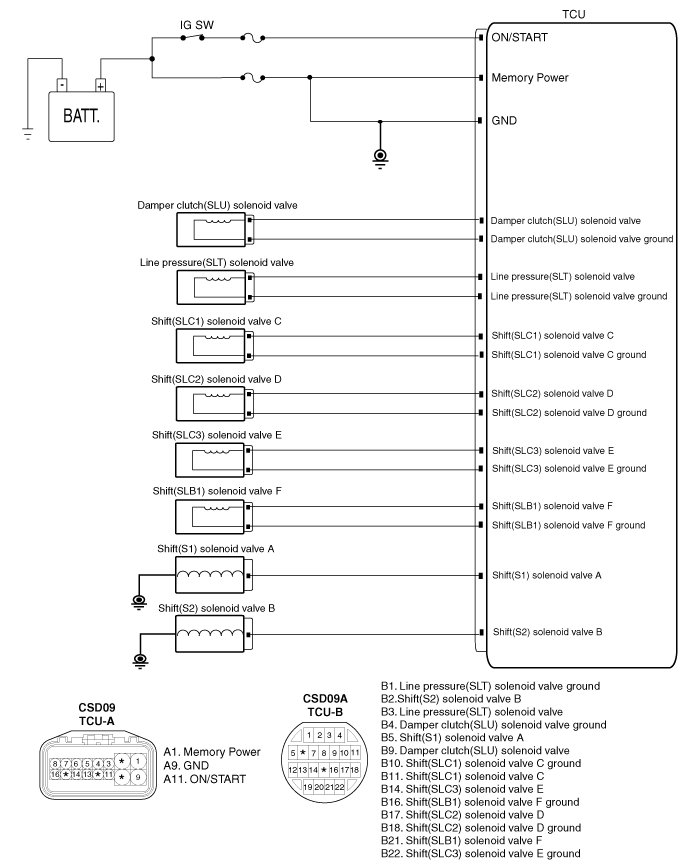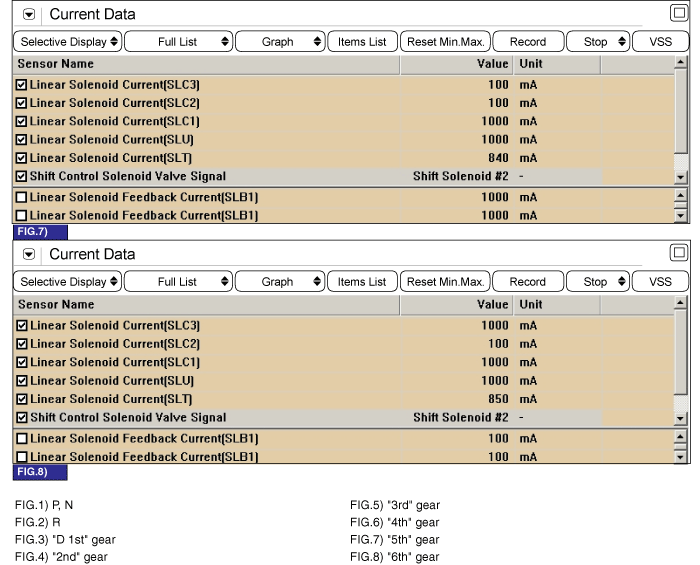
TCU monitors status of
"SHIFT SOLENOID-VALVE C(SLC3)" in order to maintain optimum gear
shift.
TCU set this code, When
Solenoid-valves are not working normally.
Item
|
Detecting
Condition
|
Possible cause
|
DTC Strategy
|
|
| •
|
Valve-body(C3,B2 pressure
system) |
|
Enable Conditions
|
| •
|
Shift lever switch =
"R"range |
| •
|
Gear position >
Reverse |
| •
|
10.2V <Battery voltage
<15.5V |
|
Threshold Value
|
| •
|
ㅣEngine speed - Input
speedㅣ<150rpm | |
Diagnostic Time
|
|
Fail Safe
|
| •
|
Self learning control is
inhibited |
| •
|
Adaptive control is
inhibited | |

| 1. |
Connect scantool to data link
connector(DLC). |
| 3. |
Monitor the all solenoid-valve parameters on
the scan tool. |
| 4. |
Shift gear at each position.



|
| 5. |
Does all "SOLENOID DUTY" follow the reference
data?
|

|
▶ Fault is
intermittent caused by poor contact in the sensor's and/or
TCM(PCM)'s connector or was repaired and TCM(PCM) memory was
not cleared. Thoroughly check connectors for looseness, poor
connection, bending, corrosion, contamination, deterioration
or damage. Repair or replace as necessary and go to
"Verification of Vehicle Repair" procedure.
|
|

|
▶ Go to
"Component inspection 1"
procedure.
|
|
| 3. |
Measure the resistance between "S1"
solenoid-valve terminal and groung terminal of "S1"
solenoid-valve. |
| 4. |
Measure the resistance between "S2"
solenoid-valve terminal and groung terminal of "S2"
solenoid-valve.
Specification
: Approx. 11~15Ω (
20°C)
| |
| 5. |
Is resistance within
specifications?
|

|
▶ Go to
"Component inspection 2" procedure.
|
|

|
▶ Replace
solenoid-valve as necessary and Go to "Verification of Vehicle
Repair"
procedure.
|
|
Component Inspection 2
| 3. |
Measure the resistance of "SLC1" "SLC2" "SLC3"
"SLB1" solenoid-valves.
Specification
: Approx. 5.0 ~ 5.6Ω (
20°C)
| |
| 4. |
Is resistance within
specifications?
|

|
▶
Substitute with a known-good PCM/TCM and check for proper
operation. If the problem is corrected, replace PCM/TCM as
necessary and then go to "Verification of Vehicle Repair"
procedure.
|
|

|
▶ Replace
solenoid-valve as necessary and Go to "Verification of Vehicle
Repair"
procedure.
|
|
NOTE)
When replacing the TCU,
must perform the N position learning and the Initial learning. (refer to
Troubleshooting's 'How to perform N position learning' and 'How to perform
initial learning')
| Verification of Vehicle
Repair |
After a repair, it is
essential to verify that the fault has been corrected.
| 1. |
Connect scan tool and select "Diagnostic
Trouble Codes(DTCs)" mode |
| 2. |
Using a scantool, Clear
DTC. |
| 3. |
Operate the vehicle within DTC Enable
conditions in General information. |
| 4. |
Are you DTCs present?
|

|
▶ Go to the
applicable troubleshooting procedure.
|
|

|
▶ System
performing to specification at this
time.
|
|